These flaky spring onion pancakes (con you bing) are a popular Chinese street food snack. You may also know them as "Scallion Pancakes". Find out how to make them below.
Vegan savoury pancakes
I first came across these spring onion pancakes while travelling in China. It was often hard to work out what was, and wasn't vegetarian (or vegan) when touring the street market but when I discovered these flaky pancakes they soon became a staple when I needed a snack on the go!
I would spot them being made on the roadside and watch as the thin discs of dough were added to hot oil, puffing up slightly but getting crisp and golden on the outside. Now when I make them at home I think back to my trip to China and all the wonderful things we ate.
You could borrow the technique for making these pancakes and flavour them with anything but I love the combination of earthy sesame and grassy spring onion. There's not much more to it than that! Simple flavours are always the best.
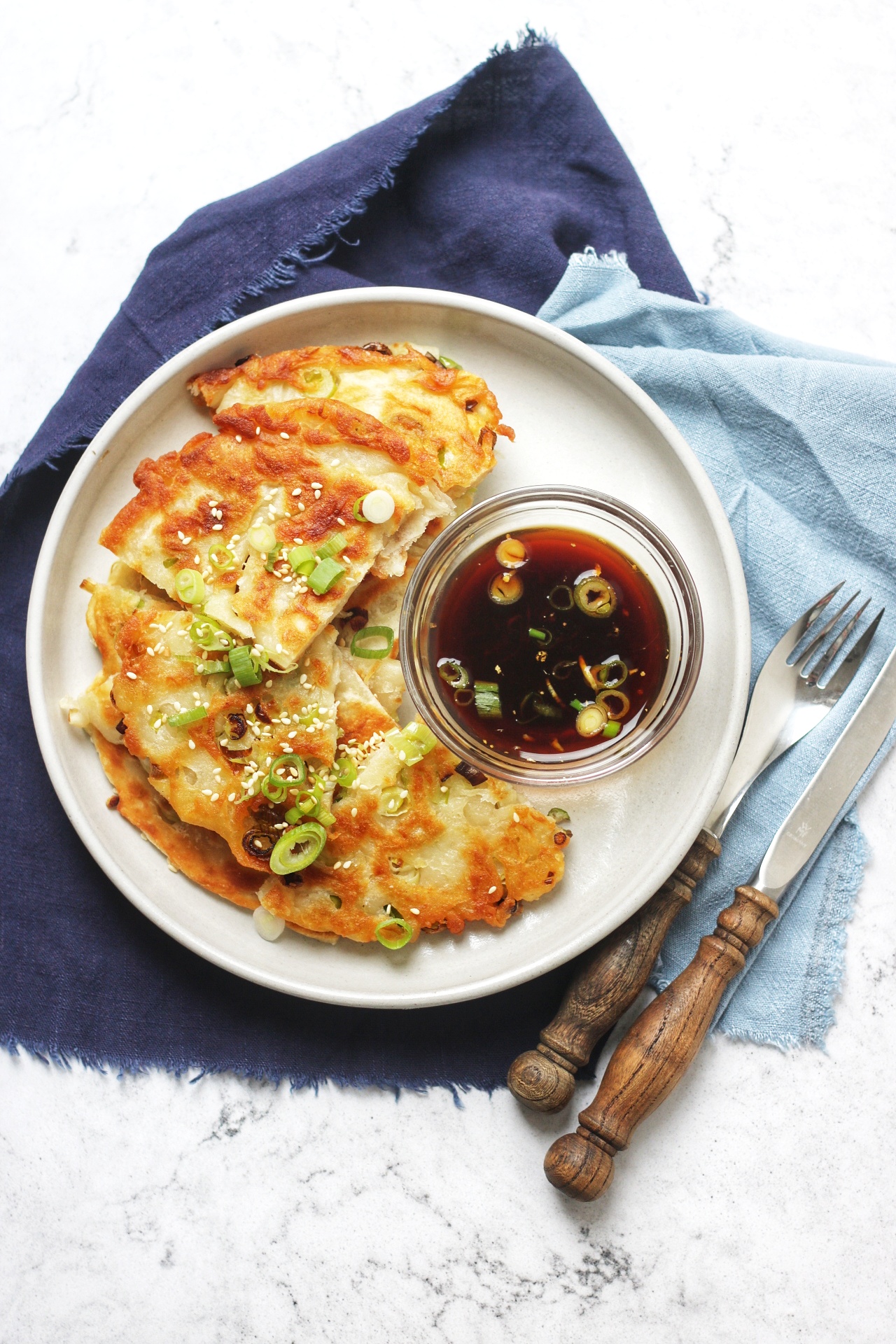
How to make your spring onion pancakes extra flaky
Unlike ordinary pancakes, they aren't made with a batter. Instead, they are made from a dough of flour and (nearly) boiling water. Making the dough with hot water and rolling and re-rolling the dough a number times is what gives these pancakes a really light, flaky texture.
It can be tempting to skip the steps of boiling the water or rolling the dough out so many times. But, I promise you it will be worth it. The more effort you put in the more flaky the pancake.
Why are spring onion pancakes made with hot or boiling water?
I've mentioned that this is a vital step for achieving flaky spring onion pancakes but what's the science behind it? When the boiling water hits the flour you will notice something strange happen. The flour will look as though it is puffing up and foaming. What's really happening is that the water is denaturing the protein. This will prevent gluten forming when we bring it together and knead it into a dough. When making a normal bread dough we want to build up gluten to create a chewy texture. But not for this recipe.
Some recipe will call for half boiling water and half cold water, but I didn't notice enough difference using that technique. I just let my boiling water cool slightly as that makes it easier to handle the dough and achieves a similar result.
How do you create the layers in a spring onion pancake?
Although the layers aren't quite the same as those you'd get in puff pastry we're going to use a simillar-ish technique. If you're familiar with making Indian parathas then you will know this technique well.
First, roll out your hot water dough on an oiled surface. Get it as thin as you can as this will create more layers. Brush it with a little sesame oil. Take the top edge of the dough and loosely roll it towards you until it's like a long piece of rope or a thin sausage shape. Next coil this piece of rope into a tight spiral. Pinch the end to the rest of the dough so that it does't unravel and then roll it out flat again.
Repeat this process as many times as you like but at least once more. On the final time of rolling it out flat, spread the surface with your thinly sliced spring onions. Roll it back up into a rope, coil it and roll it out to an 8 inch circle then fry.
The result will be a super tender, flaky spring onion pancake.
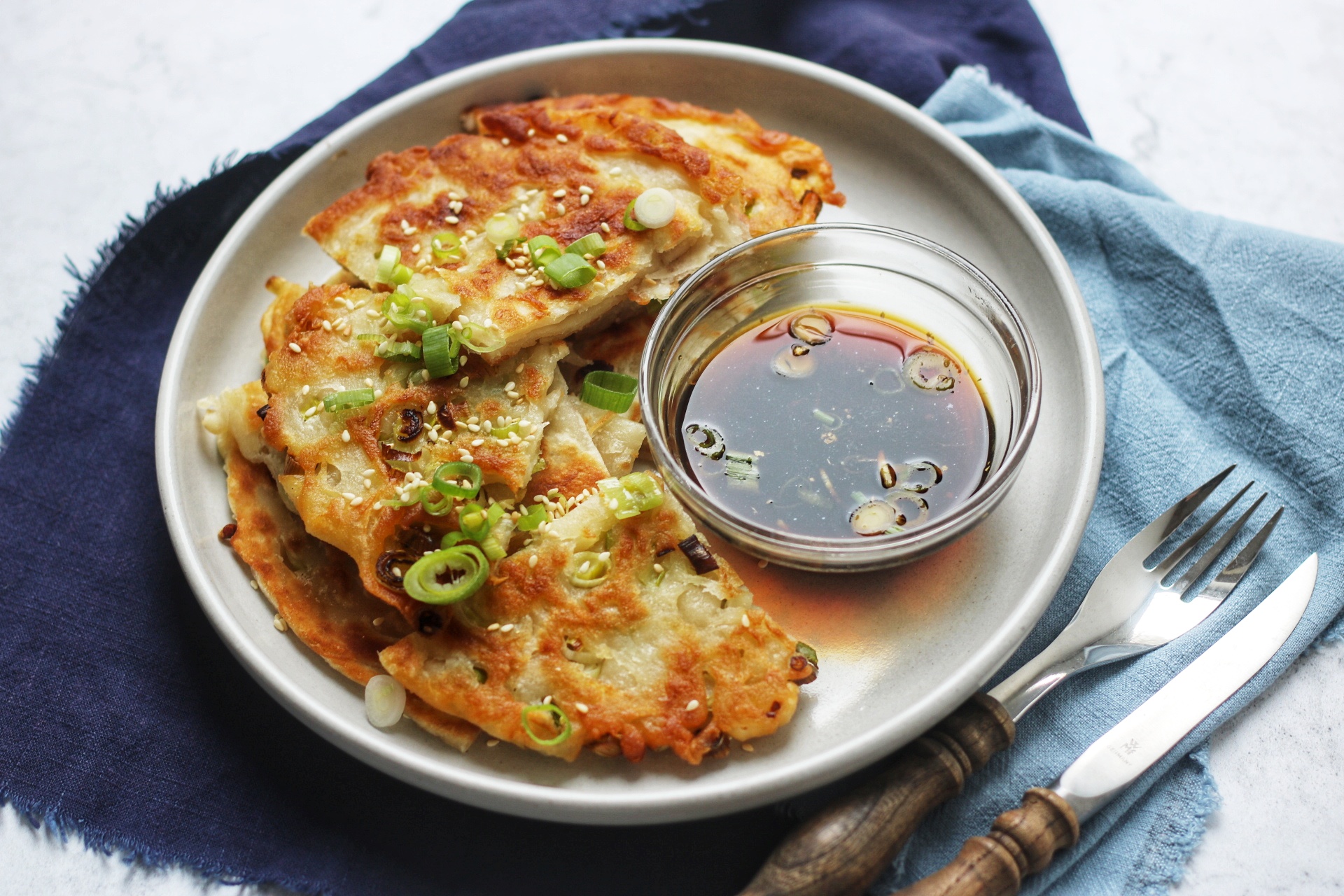
The recipe
Here you'll find a simple recipe for Flaky Spring Onion Pancakes along with a classic dipping sauce.
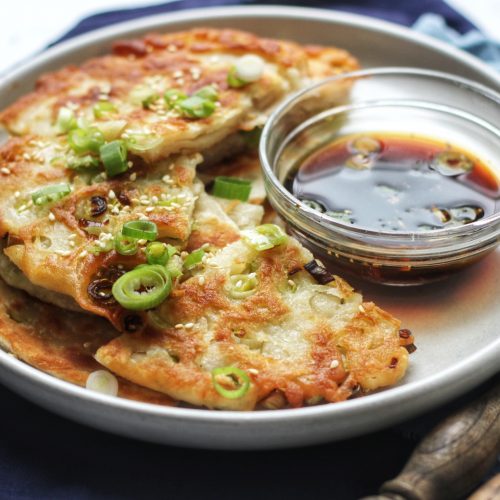
Flaky Spring Onion Pancakes
Equipment
- Rolling Pin
- Pastry brush
- Frying pan
- Tongs
Ingredients
For the spring onion pancakes
- 300 grams plain flour
- 0.5 teaspoon salt
- 250 ml water just boiled
- 75 ml sesame oil
- 8 spring onions thinly sliced
- vegetable oil for frying
- 1 tablespoon sesame seeds
For the dipping sauce
- 2 tablespoon soy sauce
- 2 tablespoon rice wine vinegar
- 2 teaspoon sugar
- 0.5 teaspoon root ginger grated
- 1 teaspoon spring onions
Instructions
To make the spring onion pancake dough
- In a bowl, sift together the flour and salt.
- Pour over the hot water and bring together into a ball of dough with a spoon or spatula (avoid using your hands as the dough will be too hot to handle!)
- Leave the dough to rest for 30 minutes.
- Once the dough has cooled and rested, divide it into 4 equal pieces.
To roll the pancake dough
- Lightly brush your surface with a little vegetable or sesame oil.
- Roll the first piece of dough out until it as thin as possible. Brush the surface of the dough with a little sesame oil then, starting from the top, roll down the dough until it is a long snake or sausage shape.
- Take one end of the snake/sausage and coil it inwards until you have a spiral shaped dough ball. Pinch the dough together to prevent it from unravelling.
- Repeat this process at least one more time.
- On the final roll, roll it out into a circle roughly 10-12 inches across. Again, brush with a little sesame oil and sprinkle over ¼ of the sliced spring onions. Push them in to the dough slightly to stop them moving.
- Roll the dough into a snack as before and then into a coil. Roll the dough out one more time to a circle roughly 8 inches across.
- Repeat this with the 3 remaining pieces of dough.
To cook the spring onion pancakes
- Place your oven on its lowest heat. This will be used to keep the cooked pancakes warm.
- Add roughly 3-4 tablespoon of vegetable oil to the frying pan and place on a medium-high heat.
- Once the oil is hot add the first pancake to the pan. Cook for 3-4 minutes until the pancake is golden brown and crispy. Flip over and repeat.
- Remove the cooked pancake from the pan and place in the warm oven while you cook the remaining 3 pancakes.
To make the dipping sauce
- Add the soy sauce, rice wine vinegar and sugar to a small bowl and whisk. Let the sugar dissolve.
- Add in the spring onions and spring onions and whisk again.
To serve
- Serve the spring onion pancakes while still warm. Cut into wedges and serve sprinkled with sesame seeds alongside the dipping sauce.
Nutrition
More recipes inspired by my trip to China
Visit the global recipe archive

Do you love to travel? Why not check out some of the recipes I've brought back from my trips abroad.

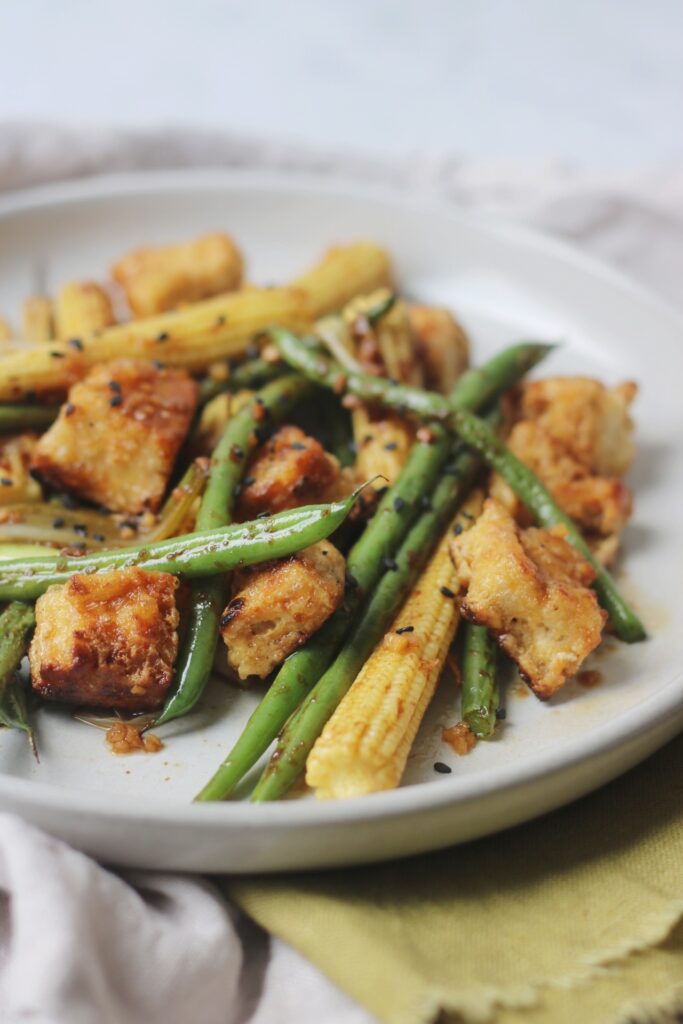
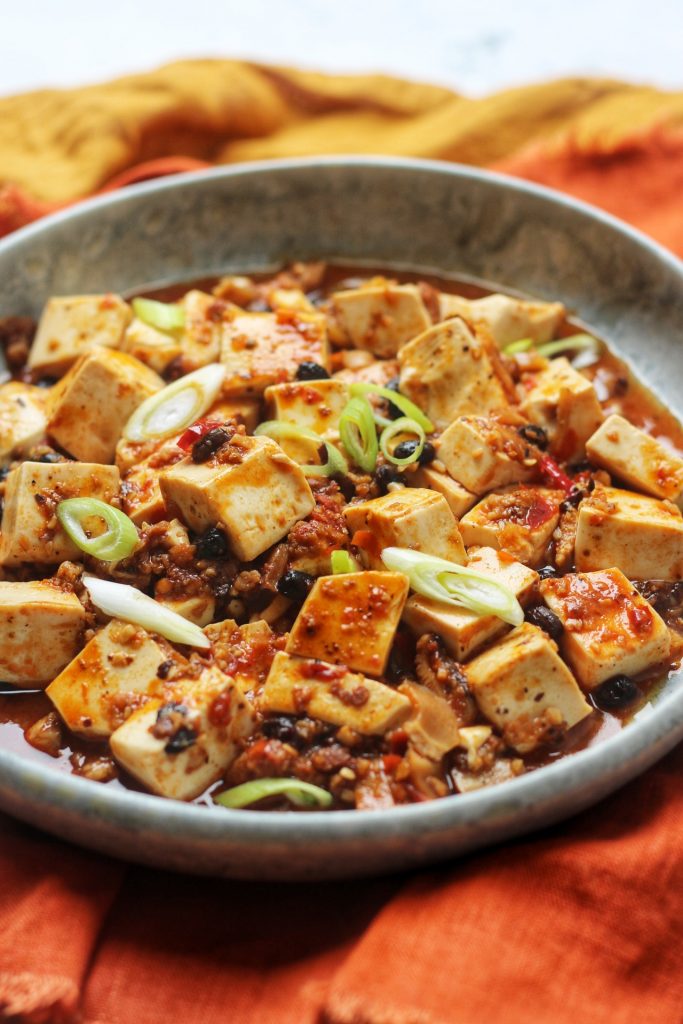
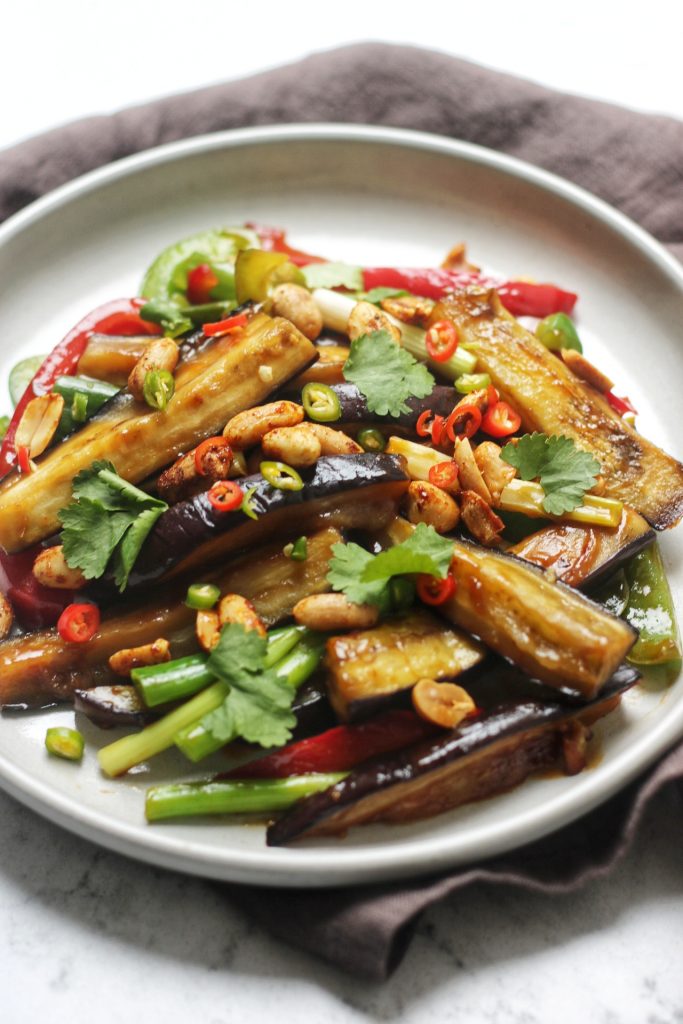
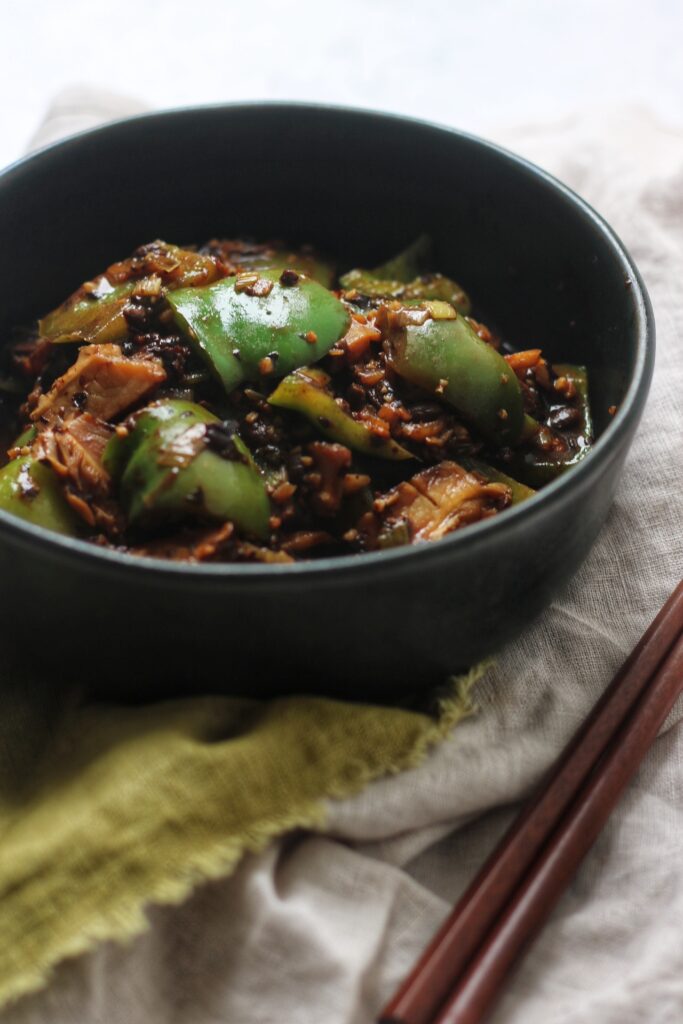
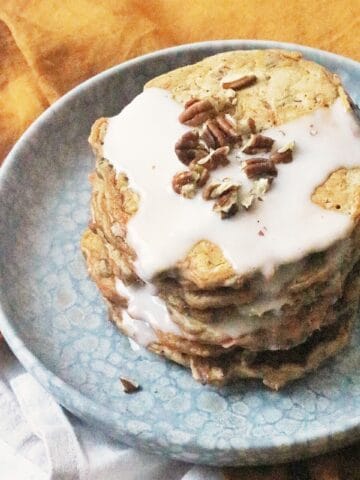
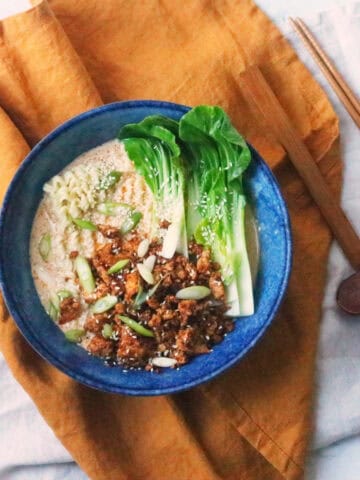
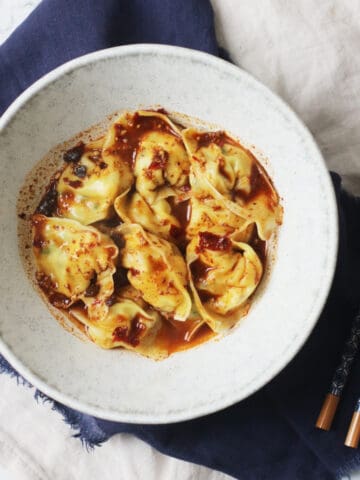

Leave a Reply